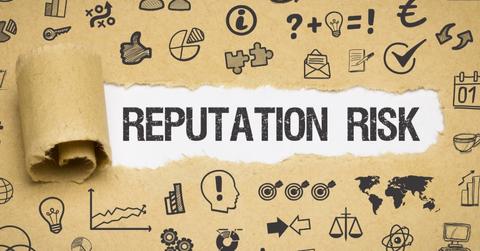Understanding Banks’ Market and Reputational Risks
All banks face risks. Two key areas to understand are banks’ market risk and reputational risk. Here’s a summary of each type.
Nov. 20 2020, Updated 11:40 a.m. ET

All banks face risks. Two key areas to understand are banks’ market risk and reputational risk. Given the amount of money they deal with, and more importantly, the fact that it’s people’s money, banks often face higher risks than other companies.
Banks’ market risk
The Basel Committee on Banking Supervision defines banks’ market risk as “the risk of losses in on- and off-balance sheet risk positions arising from movements in market prices.”
Market risk is the most prominent risk for banks offering investment banking services, because they are active in capital markets. These banks include Goldman Sachs (GS), Morgan Stanley (MS), Wells Fargo (WFC), Bank of America (BAC), and other investment banks in the Financial Select Sector SPDR ETF (XLF).
Major components of banks’ market risk
The major components of a bank’s market risk include:
- Interest rate risk.
- Equity risk.
- Foreign exchange risk.
- Commodity risk.
Interest rate risk
The potential loss due to movements in interest rates, interest risk, arises because a bank’s assets usually have a significantly longer maturity than its liabilities. In banking language, management of interest rate risk is also called asset-liability management (or ALM).
Equity risk
Equity risk is the potential loss due to an adverse change in stock price. Banks can accept equity as collateral for loans and purchase ownership stakes in other companies as investments with their free or investible cash. Any negative change in stock price either leads to a loss or diminution in investments’ value.
Foreign exchange risk
Foreign exchange risk is the potential loss due to changes in the value of a bank’s assets or liabilities resulting from exchange rate fluctuations. Banks transact in foreign exchange for their customers or through the banks’ own accounts. Any adverse movement can diminish the value of a foreign currency and cause a loss for banks.
Commodity risk
The potential loss due to an adverse change in commodity prices, commodity risk, concerns agricultural commodities (such as wheat, livestock, and corn), industrial commodities (such as iron, copper, and zinc), and energy commodities (such as crude oil, shale gas, and natural gas). The commodities’ value fluctuates a great deal due to changes in demand and supply. Commodities expose any bank holding them as part of an investment to commodity risk.
Market risk is measured by techniques such as VaR (value at risk) and sensitivity analysis. VaR is the maximum loss not exceeded with a given probability in a certain time period. Sensitivity analysis is how different values of an independent variable will impact a particular dependent variable. The chart above shows how Goldman Sachs measures its various market risks. Let’s next discuss what happens when a bank loses the public’s trust and its reputation is at stake.
Banks’ reputational risk
Reputational risk is the risk of damage to a bank’s image that occurs due to some dubious actions taken by the bank. Sometimes reputational risk can be due to perception or negative publicity against the bank, without any solid evidence of wrongdoing. Reputational risk leads to the public’s loss of confidence in a bank, and sometimes creates other problems a bank could have avoided. Most brand values stem from the reputation enjoyed by a bank.
Banks take the utmost care to maintain and enhance their reputation. Investment banks such as Goldman Sachs (GS) and Morgan Stanley (MS), commercial banks such as Wells Fargo (WFC) and Bank of America (BAC), and other banks included in the Financial Select Sector SPDR ETF (XLF) all strive to build their reputation, often through advertising that emphasizes trust.
A bank’s failure to honor commitments to the government, regulators, and the public lowers its reputation. That failure can arise from mismanagement to non-observance of codes of conduct under corporate governance.
Risks emerging from the suppression of facts and manipulation of records and accounts are also instances of reputational risk. Bad customer service, inappropriate staff behavior, and delays in decisions tarnish a bank’s public image and hamper business development.
Example of reputational risk: Wells Fargo
In April 2018, financial regulators fined Wells Fargo (WFC) $1 billion for two of its practices. The first was failing to follow the rate-lock process on its loans. Wells Fargo unfairly charged certain borrowers for delays that weren’t their fault, but rather its own. The second area where the bank failed was force-selling its insurance products. The bank tied its car insurance products to auto loans, selling the insurance to customers who didn’t really need it.
To protect its reputation, Wells Fargo refunded customers who paid the extra charge on the mortgages. It also agreed to refund customers who paid for unnecessary insurance coverage. Notably, in 2017, Wells Fargo paid $185 million in penalties for creating 3.5 million unauthorized bank and card accounts. Such incidents, if frequent, highlight weaknesses in a bank’s internal control mechanisms. They may seriously impact consumers’ confidence in a bank.
Salomon Brothers
An older but well-known example of reputational risk was that of Salomon Brothers. In the 1990s, Salomon Brothers was the fifth-largest investment bank in the US. All banks are allowed to buy government securities up to a specified limit at auctions. However, Salomon falsified records to buy government securities in quantities much larger than it was allowed.
By buying such large quantities, the bank was able to control the price investors paid for these securities. In 1991, the government caught the bank in the act, dealing a blow to Salomon Brothers’ reputation. The US government fined Salomon Brothers $290 million, the largest fine ever levied on an investment bank at the time. Although reputational risk may be more difficult to quantify than market risk, it may cost banks dearly over time.
